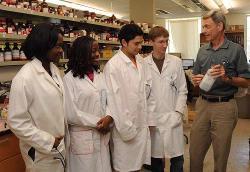
A team of student researchers in the laboratory of Paul Helquist, professor of chemistry and biochemistry, was published in the American Chemical Society's Organic Letters. The team included Asia Adams Thomas, a high school student in South Bend; Pablo Cabrera, a visiting undergraduate Guatemalan student from Regis University in Denver; Katherine Byrd, a graduate student in the lab; and Casey Cosner, a graduate student who co-mentored the students with Paul Helquist.
The article, "Selective Oxidiation of Benzylic and Allylic Alcohols Using Mn(OAc)3/Catalytic 2,3-Dichloro-5,6-dicyano-1,4-benzoquinone", describes research involved in developing a new process for oxidizing organic compounds, converting them from one class to another. The process was developed for the synthesis of histone deacetylase inhibitors that were used in a treatment that dramatically reduces cholesterol accumulation in Niemann-Pick Type C. The results of that study were also recently published.
"It was wonderfully productive," Helquist explained. "We knew at the end of the summer that it was going to lead to a publication." He further added, "The whole point of the programs in which the young students participated as research scholarship recipients is to provide them with incentives and motivation to pursue careers in science."
The university has put together these special summer research opportunities, not only for college students but also high school students. Cabrera was part of the Research Experience for Students at Catholic Colleges, a program that brings students from smaller schools to Notre Dame laboratories. He will work in Mayland Chang's laboratory in summer 2011. Thomas, who received support from the American Chemical Society's SEED program, will work with Brandon Ashfeld. Byrd has received a fellowship from the Center for Rare and Neglected Diseases.
In the picture: (l to r) Katherine Byrd, Asia Adams Thomas, Pablo Cabrera, Casey Cosner, and Paul Helquist.